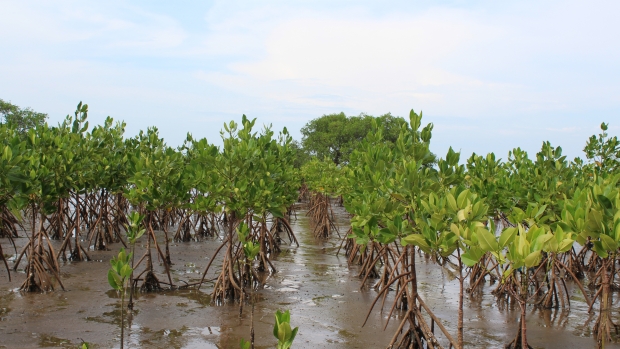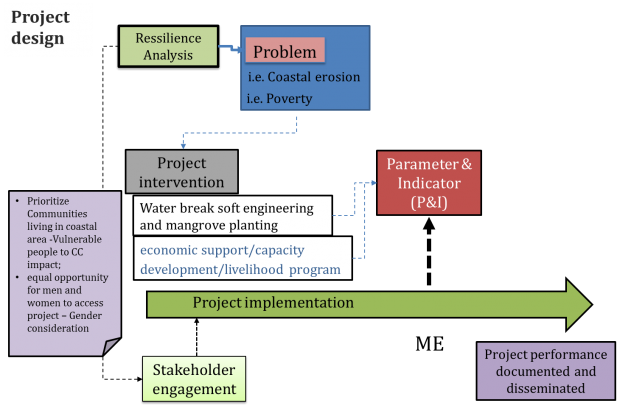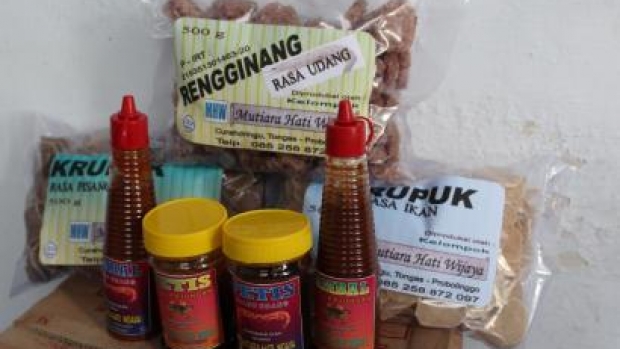Knowledge Hub :: MFF Solutions :: Environment :: Communities take the lead to rehabilitate mangroves at Bahak Indah Beach, East Java, Indonesia
Communities take the lead to rehabilitate mangroves at Bahak Indah Beach, East Java, Indonesia

Mangrove seedlings take root, Probolinggo, Indonesia, Indonesia © MFF Indonesia
Bahak Indah beach in Curah Dringu village experiences significant erosion. Mangrove forests that once protected the coastline in the area have been lost due to illegal logging and conversion to other land uses. As the coastline continues to erode this has impacts on coastal economic activities, for example tourism, and the livelihoods of local fishing communities. As a result, income from fishing and tourism activities has decreased considerably. To begin to address this problem, and with support from Mangroves for the Future, the Institute for the Study and Empowerment of Society (ISES) worked together with communities to plant mangrove in three hectares of degraded beach. By planting mangroves the local communities aimed to improve coastal resilience and reduce coastal erosion. ISES worked with small fishing communities and groups of women to plant mangroves and support the start-up of livelihood diversification activities. Two women’s groups established during the project started a small enterprise producing fish and rice crackers, and each group earned USD 150 per month from the sale of these products in local markets. Considering the success of the project, the local government and private sector were interested to support communities by scaling up mangrove and vegetation rehabilitation along the coast. Likewise, the livelihood component of the project has been replicated in an adjacent village.
Sustainable Development Goals (SDGs)
Challenges
- Coastal erosion degrading beaches and coastal wetlands.
- Local community members unaware of the suite of ecosystem services that mangroves provide.
Beneficiaries
- 100 local community members involved in mangrove rehabilitation and livelihood activities
- 2000 other inhabitants in Curah Dringu village
Building Blocks
Project design informed by situation analysis
The project was designed based on a resilience analysis in Probolinggo district. The resilience analysis helped to understand ecosystem and socio-economic conditions in the Probolinggo area. It also helped to identify actions that would directly address issues affecting coastal resource management. The analysis found that coastal erosion and poverty were the main problems contributing to coastal management issues in Probolinggo and surrounding areas. The project by ISES was designed to address these issues.
Enabling Factors
- Representative of communities, local government and private sector in Probolinggo district were involved in the process of data gathering
- This inclusive approach ensured that local perspectives were captured and that information and data about environment and socio economic conditions were relevant to the situation in Probolinggo
Lessons Learned
- The importance of engaging multiple stakeholders in situation analysis to capture information and opinions from community members as well as local government.
- The importance of taking a gender integrated approach so the views of both men and women are captured throughout the process.
Local stakeholder engagement
Local stakeholder engagement was key to achieving success in this project. Implementation of the project was led by a local NGO, the Institute for the Study and Empowerment of Society (ISES), that had a good reputation working with communities on local environmental and community livelihood issues. ISES also had a good relationship with the government. These local level relationships with both communities and government meant ISES was ideally placed to bring these stakeholders together to take action on the ground.
The local government was involved in the project from its earliest stages, and throughout project implementation and monitoring. This ensured that the project design was aligned with local government strategies and other programmes for coastal rehabilitation. Furthermore, the participation of local government throughout the project provided exposure to the project approaches to inform scaling out in other areas.
The involvement of local communities was also very important. ISES identified local community champions in the community who could promote the activities and generate continued community support.
Enabling Factors
- Local government supportive of community led action
- ISES has well established presence and reputation with local communities
- Local communities have an active interest in participating in environmental projects
Lessons Learned
- Involvement of local government throughout the project is critical for success. Consultation with local government prior to project implementation helped communities to identify a suitable rehabilitation site and to avoid duplicating activites. The involvement of local government early on also helped maintain government engagement throughout implementation of the project.
- The involvement of local community champions, both from the local NGO and communities, ensured good collaboration.
Gender integrated approach
Gender was considered in project design to ensure participation of both men and women decision making about project design and the implementation of activities. It was agreed that at least 40% of participants in project activities must be women. To facilitate the inclusion of women further, regular meetings were held throughout implementation inviting all members of the community to be informed about the progress of the project and seek input on future plans.
Enabling Factors
- The project implementer, ISES, was aware of gender issues in coastal restoration projects
- Communities were open to specifically addressing women’s needs during the project design and implementation.
Lessons Learned
-
By actively seeking their input throughout the project, addressing their needs, and helping them to earn additional household income, it was observed that women felt more empowered and were more confident to voice their opinion in decision making fora.
Sharing lessons learned
Project results were documented to capture project performance, success stories and failures. Project achievements and challenges were shared through a lesson-learned workshop at the local level, with national level actors via a national seminar, and the International Conference on Sustainable Mangrove Ecosystems held in Bali in April 2017. Project factsheets and a lessons learned document were also distributed at these events. ISES also active engaged with local media to raise awareness about the project and its response to coastal management issues.
Enabling Factors
- ISES had an existing network and relationships with local media outlets.
- The MFF National Coordinating Body took an active interest in documenting the tangible outcomes of the project.
Lessons Learned
- Sharing knowledge and lessons learned is a strategic tool to facilitate scaling up. Knowledge sharing also benefits other stakeholders to help inform them of what works and what doesn’t, helping to avoid failures in the future.
How do the building blocks interact?
The Resilience Analysis contributed to more strategic selection of activities to address issues at the target site. Local stakeholders’ involvement in the analysis ensured that their views were captured when it came to making decisions about what needs to be done. This also meant they had a vested interest in the success of project.
Local government engagement in the project development ensured the activities suited with government’s programme at the local level. The involvement of local government in project design, and in project implementation, also ensured the activities were adequately monitored and knowledge was shared for scaling up.
A gender-integrated approach ensured that the views and contributions of both men and women were equally considered throughout the development and implementation of the project.
Sharing lessons learned provided an avenue for the project activities to be scaled up; mangrove rehabilitation activities by local government and livelihood activities by a neighbouring community. Communicating about the projects successes and challenges also inspires others to take similar action.

Impact
- About 40,000 mangroves and 500 casuarina seedlings were planted along the Bahak beach with the survival rate of 75%. Building on this success the local government planted 50,000 mangroves in nearby areas.
- Two women’s groups in Curah Dringu village established a small scale enterprise producing fish and rice crackers for sale. Each group earns USD 150 per month from the sale of these products.
- Local communities more aware of the importance of mangrove forests
An Inspiring Story
Bahak Indah beach covers a 2km stretch running along the coast of Curah Dringu village, located in Probolinggo District, East Java Province. The area was a major attraction for visitors, and a place where locals sold food and drink, and rented bicycles to tourists. Unfortunately, many mangroves were cut illegally in the beach area. Villagers were not aware of the important function of mangroves protecting the beach and nearby villages from violent storms and erosion. Coastal erosion has become the major threat to the well-being of Curah Dringu communities, affecting both the environment around them and the source of their livelihood such as fishing.
With the support of MFF, ISES together with small fishing communities restored the area by planting mangrove along the coast of the Bahak beach and constructing ‘soft infrastructure’, such as long bamboo fences, to ease the impact on incoming waves and reduce erosion. Mangroves are now thriving along the beach. The mangroves also protect the community shrimp ponds, a major source of income in the local community, from surging waves.
Local women in the communities also wanted to diversify the sources of income for their families. Two women groups were formed to produce fish and rice crackers and shrimp paste. Additional income generated by the groups was estimated more than USD 150 per month. Following the MFF project, the businesses have also started to produce other products, such as banana crackers. Their snacks became so popular they received orders of about 1,000 packages of crackers per day from stores in neighbouring Pasuruan city. These activities have inspired other surrounding communities who have now formed a similar group and started their own fish cracker enterprise.
Recognising the success of these activities the local government was keen to express their gratitude for the dedication of the community. Mr. Samsuri, a community leader involved in the project received an award from the Probolinggo District government for his dedication to environmental conservation. He was also invited by the Islamic State University of Sunan Ampel, Surabaya to speak at a seminar on Sustainable Mangrove Ecosystem Management. The community of Curah Dringu was visited by students from a nearby university to see the results of the project and hear ‘first hand’ from people in the village about their experiences in coastal conservation.

Fish and rice crackers, and other products, produced by the ... , Indonesia © MFF Indonesia
Project Facts
Country
Location
Curah Dringu village, Probolinggo, East Java, Indonesia
Topic
Duration
2nd Mar 2016 to 31st Dec 2016
Implementing Partner
Institute for The Study and Empowerment of Society (ISES)